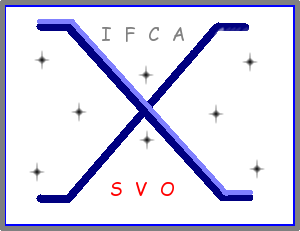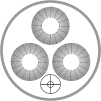
AXIS/XMS SSAP resource


The XMM-Newton observatory, the second cornerstone of the Horizon 2000 science programme of the European Space Agency, was successfully launched on the 10th of December 1999. XMM-Newton is a powerful observatory in X-rays up to 10 keV, opening an almost unexplored window to the Universe. The sensitivity to hard X-rays has allowed the detection and study of the most energetic objects in the Universe. Most of these are deeply hidden inside large amounts of absorbing gas and inconspicuous at most all other wavelengths. A major goal of XMM-Newton -and of the AXIS programme- is to characterize the xray sky up to energies of 10 keV.
During a typical science observation, XMM-Newton can discover ca. 50-250 new X-ray sources and add to the XMM-Newton serendipitous survey at an expected rate of 30000 new sources per year. The XMM-Newton Survey Science Centre (SSC) was appointed by ESA to exploit scientifically the XMM-Newton serendipitous survey for the benefit of the scientific community and as a major legacy of XMM-Newton to future generations. This is being tackled by the SSC consortium in terms of an (mostly ground-based) X-ray follow-up and identification (XID) programme.
The goal of the XID programme is to exploit fully the XMM-Newton serendipitous sky survey. Its implementation has been divided into two parts: a core programme which has identified -spectroscopically- significant samples of sources at X-ray flux limits of 1 E-13 erg/cm2/s (bright sample), 1 E-14 erg/cm2/s (medium sample) and 1 E-15 erg/cm2/s (faint sample) covering a range of galactic latitudes, and an imaging programme aiming at providing deep optical/infrared images in several colours of a large number of XMM-Newton fields to facilitate statistical identifications of the serendipitous sources. Those programmes are completed by the effort compiling the XMM-Newton source catalogue which contains the sources detected by this observatory.AXIS (An XMM-Newton International Survey) is a key element of the compilation of medium-sensitivity surveys with XMM-Newton.
For the AXIS programme, a total of 36 XMM-Newton-Newton observations were selected for optical follow-up of X-ray sources, with a preference for those that were public early in the mission (mid 2000), or part of the SSC Guaranteed Time Program. The fields were selected having |b|>20°, total exposure time >15 ks, and excluding (optical and X-ray) bright or extended targets (except in two cases: A1837 and A399). After discarding the observing intervals within observations having high background rates, a few of the fields have final exposure times shorter than 15 ks. A few fields (some with shorter exposure times) were also included to expand the solid angle for bright X-ray sources. All of these fields have been used for the study of cosmic variance, the angular correlation function and the determination of logN-logS in different bands (see details in Carrera F.J. et al. 2007, A&A 469, 27-46).
The optical spectra have been taken using different ground based facilities. In addition to the standard information provided by each observatory in the header files and to the standard keywords for SSAP publication, the FITS spectral files also contain a list of relevant keywords (see table 2) identified by the prefix AXIS (for instance AXISRA for the RA position) to help to identify the source.
| Keyword Name | Description | Example |
| AXISRA | RA J2000 of AXIS source (deg) | 225.5284 |
| AXISDEC | DEC J2000 of AXIS source (deg) | -7.647069 |
| AXISRUN | AXIS Run number (YYMMTEL) | 0107WHT |
| AXISDATE | AXIS obs. date (YYMMDD) | 010725 |
| AXISTEL | Telescope for Observation | WHT |
| AXISINST | Instrument used in Observation | WYFFOS |
| AXISFITS | AXIS original FITS spectral filename | SW_UZLib.1.ms.fits |
| AXISSPN | AXIS spectral order number | 1 |
| AXISFIBR | Source identification in FIBRE file | X030_A |
The name of the spectral files displayed by the SSAP resource contains information about the instrument it was observed with and the name/number in the AXIS database (see Table 3).
| File name | Telescope | Instrument/Survey |
|---|---|---|
| S2_ | AAT | 2dF |
| SA_ | NOT | ALFOSC |
| SB_ | WHT | ISIS Blue arm |
| SC_ | CAHA-2.2 | CAFOS |
| SD_ | TNG | DOLORES |
| SE_ | NTT | EMMI |
| SF_ | INT | FOS |
| SG_ | GEMINI | GMOS-S |
| SM_ | CAHA-3.5m | MOSCA |
| SO_ | SAO-6m | SCORPIO |
| SR_ | WHT | ISIS Red arm |
| SS_ | FOCAS | Subaru |
| SV_ | FORS2 | ESO-VLT |
| SW_ | WHT | WYFFOS |
| Sb_ | Keck II or CAHA-3.5m | DEIMOS B or TWIN B |
| Sr_ | Keck II or CAHA-3.5m | DEIMOS R or TWIN R |
Last Modified on Wed May 19 2010 by M.Ceballos
Contact: